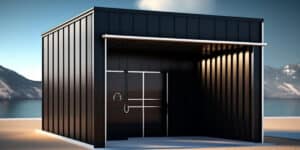Unlocking the Potential: Exploring the Benefits of Building a Garage with Shipping Containers
In recent years, building structures using shipping containers has gained popularity among homeowners and architects alike. These versatile and durable containers have proven to be a cost-effective and eco-friendly solution for various construction projects, including the creation of garages. By repurposing shipping containers, homeowners can unlock the potential of their properties and enjoy numerous benefits. In this article, we will explore the advantages of building a garage with shipping containers.
1. Affordability
One of the primary reasons homeowners are turning to shipping containers for garage construction is their affordability. Compared to traditional building materials, such as bricks or wood, shipping containers offer a cost-effective alternative. The containers themselves are readily available at a fraction of the cost of constructing a garage from scratch. Additionally, the modular nature of shipping containers allows for easy customization and expansion, eliminating the need for costly architectural designs.
2. Quick and Efficient Construction
Another significant advantage of building a garage with shipping containers is the speed and efficiency of the construction process. Unlike traditional construction methods, which can take months or even years, shipping container garages can be assembled in a matter of weeks. This expedited timeline is possible because the containers are pre-fabricated and require minimal on-site work. Once the containers are delivered and properly positioned, it is simply a matter of connecting them and adding necessary finishing touches.
3. Durability and Security
Shipping containers are designed to withstand harsh conditions while protecting the cargo they carry. This inherent durability makes them an excellent choice for building a garage. Constructed from weather-resistant steel, shipping containers are resistant to rust, corrosion, and damage from pests. Additionally, their sturdy construction provides enhanced security, protecting your vehicles and belongings from theft and vandalism. With proper maintenance, a shipping container garage can last for decades, providing a long-term solution for your storage needs.
4. Versatility and Customization Options
Shipping containers offer unparalleled versatility and customization options for garage construction. With the ability to stack and combine containers, homeowners can create garages of various sizes and configurations to suit their specific needs. Containers can be modified to include windows, doors, ventilation systems, and even insulation, ensuring a comfortable and functional garage space. Furthermore, the external appearance of shipping container garages can be easily enhanced with paint or cladding, allowing homeowners to match their existing property aesthetic.
5. Eco-Friendly Solution
In an era where sustainability is a growing concern, building a garage with shipping containers offers an eco-friendly solution. By repurposing existing containers, homeowners are reducing waste and minimizing the demand for new construction materials. Additionally, the steel used in shipping containers is highly recyclable, making it an environmentally conscious choice. Furthermore, the energy requirements for heating and cooling a shipping container garage can be significantly lower compared to traditional garages, leading to reduced energy consumption and carbon footprint.
Conclusion
Building a garage with shipping containers provides homeowners with a multitude of benefits, including affordability, quick construction, durability, versatility, and eco-friendliness. By utilizing these repurposed structures, homeowners can unlock the potential of their properties and create functional and stylish garages. Whether you need additional storage space or a secure shelter for your vehicles, consider the advantages of shipping container garages and explore the endless possibilities they offer.
From Shipping to Storage: How to Transform Shipping Containers into a Functional Garage
When it comes to finding extra storage space or a place to park your vehicles, traditional options can be expensive and time-consuming. However, there is a growing trend that provides an innovative and cost-effective solution: transforming shipping containers into functional garages. These sturdy, weather-resistant structures offer a multitude of benefits and can be customized to suit your needs. In this blog post, we will explore the steps involved in transforming a shipping container into a functional garage.
Step 1: Selecting the Right Container
The first step in this transformation process is to choose the right shipping container. Standard shipping containers come in various sizes, including 20-foot and 40-foot options. Consider your storage needs and the available space on your property when selecting the size. It’s also essential to inspect the container for any damage or corrosion that could impact its structural integrity.
Step 2: Preparing the Container
Before you can start transforming the shipping container, it’s crucial to prepare it properly. Begin by cleaning the container thoroughly, removing any dirt, dust, or residue. Next, inspect the interior for any signs of rust or damage. If necessary, treat the affected areas with a rust converter and apply a rust-resistant primer to prevent further corrosion.
Step 3: Insulation and Ventilation
Shipping containers are typically made of steel, which can make them susceptible to extreme temperatures. To ensure your garage remains comfortable and well-insulated, consider adding insulation. Fiberglass insulation is a popular choice, as it is cost-effective and easy to install. Additionally, proper ventilation is essential to prevent condensation buildup. Install vents or fans to promote airflow and prevent moisture-related issues.
Step 4: Flooring and Lighting
Once the insulation and ventilation are in place, it’s time to focus on the flooring. Depending on your needs and preferences, you can choose from various flooring options, including concrete, epoxy, or even wooden decking. Consider the type of vehicles or equipment you plan to store in the garage and select a flooring material that can withstand the weight and provide adequate protection.
Proper lighting is another crucial aspect of a functional garage. Install LED lights to ensure bright and efficient illumination. LED lights are energy-efficient, long-lasting, and provide better visibility than traditional lighting options.
Step 5: Customization and Security
To make your shipping container garage truly functional, consider adding custom features and security measures. This could include adding windows for natural light, installing a roll-up door for easy access, or incorporating shelving and storage solutions to maximize space utilization. Additionally, consider adding security features such as lockable doors, motion sensor lights, or a security system to protect your belongings.
Step 6: Exterior Upgrades
While the interior is essential, don’t forget about the exterior of your shipping container garage. Consider painting the exterior to match your property’s aesthetics or applying weather-resistant coatings to ensure durability. You may also want to add landscaping elements or a paved driveway to enhance the overall curb appeal.
Step 7: Maintenance and Upkeep
Once your shipping container garage is complete, it’s important to establish a regular maintenance routine. Inspect the structure periodically for any signs of rust, damage, or leaks. Keep the interior clean and organized to prevent clutter and ensure easy access to your stored items. Regularly check the insulation and ventilation systems to maintain a comfortable environment.
Conclusion
Transforming a shipping container into a functional garage is an innovative and cost-effective way to create extra storage space or protect your vehicles. By following these steps, you can customize your container to suit your needs, ensure proper insulation and ventilation, and enhance security. With proper maintenance and upkeep, your shipping container garage will provide a functional and durable solution for years to come.
Thinking Outside the Box: Designing and Constructing Your Dream Garage with Shipping Containers
Are you tired of the same old garage designs? Do you yearn for a space that not only protects your vehicles but also showcases your unique style? Look no further than shipping containers! These versatile, cost-effective, and sustainable structures are revolutionizing the way we think about garages. In this blog post, we will explore the benefits of using shipping containers to create your dream garage and provide you with some creative design ideas to get you started.
The Advantages of Using Shipping Containers
Durability and Security
One of the most significant advantages of using shipping containers for your garage is their exceptional durability. Built to withstand the harsh conditions of sea travel, these containers are constructed from robust steel, making them resistant to extreme weather, pests, and potential break-ins. With a shipping container garage, you can have peace of mind knowing that your vehicles and belongings are safe and secure.
Affordability
Building a traditional garage from scratch can be a costly endeavor. However, shipping containers offer a cost-effective alternative. These containers are readily available in most regions, and their prices are often significantly lower than constructing a conventional garage. Moreover, shipping containers are designed to be stackable, allowing for potential expansion and customization as your needs evolve over time.
Sustainability and Eco-friendliness
In an era where sustainability is becoming increasingly important, using shipping containers as a building material is an excellent choice. By repurposing these containers, you are reducing waste and giving them a second life. Additionally, shipping containers can be easily modified to incorporate eco-friendly features such as solar panels, rainwater harvesting, and green roofs, further reducing your carbon footprint.
Versatility and Customizability
Shipping containers provide endless possibilities when it comes to design and customization. Their modular nature allows for easy expansion, and they can be stacked and combined to create unique and multi-functional spaces. Whether you envision a garage with additional storage, a workshop, or even a home office above it, shipping containers can be tailored to meet your specific needs.
Design Ideas for Your Dream Garage
Industrial Chic
Embrace the raw and rugged aesthetic of shipping containers by leaving the exterior untouched or opting for a minimalistic industrial finish. Consider adding large windows and glass doors to flood the space with natural light, creating a bright and inviting atmosphere. Inside, you can incorporate exposed brick walls, reclaimed wood accents, and metal fixtures to enhance the industrial vibe. This design is perfect for car enthusiasts who appreciate a modern, edgy aesthetic.
Rustic Retreat
If you prefer a more cozy and rustic ambiance, transform your shipping container garage into a charming retreat. Use natural materials like wood paneling on the exterior and add a front porch with comfortable seating. Inside, create a warm and inviting space with wooden beams, vintage lighting fixtures, and rustic furniture. This design is ideal for those who want their garage to be an extension of their home, where they can relax and enjoy their hobbies.
Green Oasis
For those with a green thumb, consider incorporating a lush garden on the roof of your shipping container garage. With proper insulation and waterproofing, you can create a rooftop oasis filled with vibrant plants, flowers, and even a small vegetable garden. This design not only adds beauty to your property but also provides additional insulation, reducing heating and cooling costs. Imagine parking your car beneath a canopy of greenery every day!
Conclusion
Designing and constructing your dream garage doesn’t have to be a conventional and mundane process. By thinking outside the box and utilizing shipping containers, you can create a unique, durable, and eco-friendly space that reflects your personal style. Whether you opt for an industrial, rustic, or green design, the possibilities are endless. Embrace innovation, sustainability, and customization by choosing shipping containers for your dream garage project.
The Ultimate DIY Garage: A Step-by-Step Guide to Building a Shipping Container Garage
Are you in need of a spacious and sturdy garage for your vehicles and tools? Look no further than a shipping container garage! These versatile structures have gained popularity in recent years due to their affordability, durability, and eco-friendly nature. Building your own shipping container garage is not only a great DIY project but also a practical solution for those who want a functional and unique space. In this step-by-step guide, we will walk you through the process of building your very own shipping container garage.
Step 1: Planning and Design
The first step in any construction project is careful planning and design. Determine the size of the garage you require based on the number and size of vehicles you plan to store. Consider additional space for a workshop, storage, or even a small office. Sketch out a rough floor plan to visualize the layout and make sure you include all the essential features.
Step 2: Sourcing and Preparing the Containers
Next, you’ll need to source the shipping containers. Look for reputable suppliers who offer high-quality containers that are in good condition. Consider the dimensions and condition of the containers to ensure they meet your requirements.
Once you have your containers, it’s time to prepare them for construction. Inspect the containers for any damages and make necessary repairs. Remove any existing flooring and clean them thoroughly. Apply rust-resistant coatings to prevent corrosion and extend the lifespan of the containers.
Step 3: Foundation and Site Preparation
Before placing the containers, you’ll need to prepare the site and construct a solid foundation. Clear the area of any debris or vegetation. Depending on your location and soil conditions, you may need to pour a concrete slab or create a pier foundation. Consult with a professional to determine the most suitable foundation for your project.
Step 4: Container Placement and Structural Modifications
With the foundation in place, it’s time to position the containers. Use heavy-duty equipment like cranes or forklifts to carefully lift and place the containers onto the foundation. Ensure they are level and properly aligned.
To create openings for doors, windows, and ventilation, you’ll need to make structural modifications to the containers. This can be done using cutting tools like grinders or plasma cutters. Reinforce the openings with steel frames and weld them securely to maintain structural integrity.
Step 5: Insulation and Interior Finishing
To make your shipping container garage comfortable and energy-efficient, insulation is crucial. Apply insulation materials to the interior walls and ceiling of the containers. Options like spray foam insulation or rigid foam boards provide excellent thermal insulation properties.
Once the insulation is in place, it’s time to tackle the interior finishing. Install drywall or plywood over the insulation to create a finished look. Consider adding electrical wiring, lighting fixtures, and outlets according to your needs. Don’t forget to insulate and finish the garage doors as well.
Step 6: Exterior Modifications and Finishing Touches
To enhance the aesthetic appeal of your shipping container garage, you can make exterior modifications. This can include adding cladding materials like wood, metal panels, or even a living wall. Paint the exterior to protect the containers from rust and give them a fresh look.
Don’t forget to install proper drainage systems and gutters to prevent water damage. Consider adding a roof overhang or a canopy to provide shade and protect the containers from excessive heat or rain.
Step 7: Security and Access
Finally, ensure your shipping container garage is secure and easily accessible. Install sturdy locks on all doors and windows to safeguard your vehicles and belongings. Consider adding security cameras or an alarm system for added protection.
Create convenient access points such as ramps or stairs for easy entry and exit. If desired, install a garage door opener for added convenience.
Step 8: Personalization and Organization
Now that your shipping container garage is complete, it’s time to personalize and organize the space. Add shelves, cabinets, and workbenches to maximize storage and create a functional workspace. Consider installing a ventilation system to keep the air fresh and prevent condensation.
Paint the interior walls, hang posters, or add your personal touch to make the space truly yours. Organize your tools and equipment so that everything is easily accessible and well-maintained.
Conclusion
Building a shipping container garage is an exciting DIY project that offers a unique and functional space for your vehicles and tools. With careful planning, proper preparation, and attention to detail, you can create the ultimate DIY garage that meets your specific needs. Follow this step-by-step guide, and soon you’ll have a durable, eco-friendly, and stylish space that you can proudly call your own. Happy building!
Shipping Containers Reimagined: Creating an Eco-Friendly Garage Solution
In recent years, there has been a growing trend towards repurposing shipping containers for various purposes. These versatile and durable structures have found a new lease on life as eco-friendly solutions for residential and commercial spaces. One such creative application is using shipping containers to create an eco-friendly garage solution.
The Appeal of Shipping Containers
Shipping containers have gained popularity due to their numerous advantages. Firstly, they are readily available and relatively inexpensive compared to traditional building materials. Secondly, their robust construction makes them highly durable and resistant to harsh weather conditions. Finally, repurposing shipping containers helps reduce waste and contributes to a more sustainable approach to construction.
Transforming a Shipping Container into a Garage
Transforming a shipping container into a garage is a unique and innovative way to create a functional space while reducing the environmental impact. Here are some key steps involved in the process:
1. Selecting the Right Container
When choosing a shipping container for your garage project, it’s important to consider factors such as size, condition, and structural integrity. Containers come in various sizes, with the most common options being 20 or 40 feet in length. Assess the condition of the container, ensuring that it is wind and watertight, with minimal rust or damage.
2. Planning and Design
Before starting the transformation process, it’s crucial to plan and design the garage layout. Consider factors such as the number of vehicles you want to accommodate, storage needs, and any additional features you desire. Sketch out your ideas and consult with professionals if needed to ensure structural integrity and adherence to local building codes.
3. Insulation and Ventilation
To create a comfortable and energy-efficient garage, insulation is essential. Shipping containers are made of steel, which can conduct heat and cold. Adding insulation to the walls, ceiling, and floor will help regulate the internal temperature and reduce energy consumption. Proper ventilation is also crucial to prevent moisture buildup and maintain air quality.
4. Doors and Windows
The next step is to install suitable doors and windows for your garage. Depending on your preferences, you can choose from a variety of options, including roll-up doors, sliding doors, or traditional hinged doors. Windows can bring in natural light and enhance the aesthetics of the space.
5. Electrical and Plumbing
If you plan to use your garage for more than just parking vehicles, consider adding electrical and plumbing connections. This will allow you to power tools, install lighting fixtures, and even incorporate a small bathroom or sink if desired. Consulting with a licensed electrician and plumber is essential to ensure safety and compliance with regulations.
6. Customization and Aesthetics
Once the basic structure is in place, it’s time to add personal touches and make the space your own. Consider painting the exterior to match your home or adding siding materials for a more finished look. Inside, you can customize the space with storage solutions, workbenches, and shelving to maximize functionality.
The Benefits of an Eco-Friendly Garage Solution
Opting for a shipping container garage offers several benefits in terms of sustainability and environmental friendliness. Here are some of the key advantages:
1. Recycling and Reducing Waste
Repurposing shipping containers helps reduce waste by giving them a second life instead of ending up in landfills. By using existing structures, you minimize the need for new materials, saving energy and resources.
2. Energy Efficiency
Proper insulation and ventilation ensure energy efficiency within the garage. By regulating the internal temperature, you reduce the need for excessive heating or cooling, leading to lower energy consumption.
3. Durability and Longevity
Shipping containers are built to withstand the rigors of international shipping, making them highly durable. By utilizing this robust construction, you create a garage that will stand the test of time, reducing the need for frequent repairs or replacements.
4. Portability and Flexibility
One of the unique advantages of shipping container garages is their portability. If you ever decide to move or relocate, you can easily transport your garage to your new property. Additionally, containers can be modified and expanded to accommodate changing needs, providing flexibility for future use.
Conclusion
Repurposing shipping containers as eco-friendly garage solutions is an innovative and sustainable approach to construction. By transforming these versatile structures, you can create a functional space while minimizing waste and reducing your environmental impact. Whether you need a simple storage area or a fully-equipped workshop, a shipping container garage can cater to your needs while promoting sustainability.




